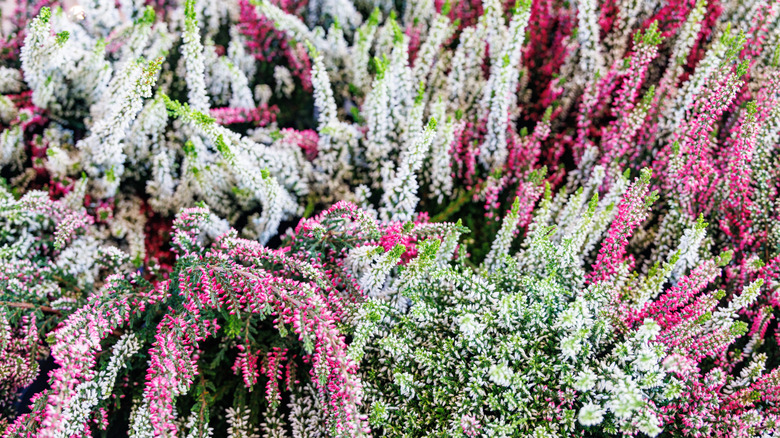The Easy-To-Grow Evergreen Ground Cover That Happily Fills In A Boring Landscape
There's a whole bunch of delightful ground cover plants that will give color in the garden all year round, but few are as easy to grow or offer the versatility of winter heath (Erica carnea). The evergreen shrub is also known as snow heath, spring heath, and alpine heath, and as keen gardeners will guess from the Latin name "Erica," is a type of heather.
Winter heath's low, spreading habit makes it ideal for filling in a boring landscape. The dense growth also means that this ground cover is good at suppressing weeds. Plants typically reach from 6 to 12 inches tall and 18 inches across and the flowers provide vibrant color from January through to the middle of spring. Flowers range from white, through pink and red, to purple. Meanwhile, the foliage is often green but can be yellow or gold. Winter heath clings to slopes, wanders under trees, is great for rock gardens, and grows well in containers. As a bonus, winter heath supplies nectar for bees.
There are over 100 cultivars of winter heath. It's originally from the European Alps, and in the U.S., most winter heath varieties are hardy in zones 7 through 9. If you're not sure whether your local climate is right for this ground cover, find out what USDA growing zone you're living in.
How to grow and care for Winter Heath
Most of the general tips and tricks for growing ground cover plants apply to winter heath, although it's less fussy than its peers. Like most heathers, winter heath prefers acidic soil but doesn't mind if it's a bit alkaline. In fact, tolerates most soil conditions well. However, if you've got clay, you'll want to add some grit to improve drainage in the soil. It's happy in winter sun but will prefer some shade to protect it during summer in the scorching southern states.
Winter heath needs regular watering during its first year, but it's important to avoid overwatering in heavy soils, as too much moisture can lead to root rot. This ground cover normally has few problems, is not usually eaten by deer, and is untroubled by salty air in coastal regions. That said, be on the lookout for powdery mildew, rust, and wilt. Trim winter heath's flower heads once they start to fade (imagine giving it a haircut with your garden shears), and don't procrastinate — the next year's flower buds start to form soon after. Trimming will also help keep the plant neat and keep it from getting leggy.

